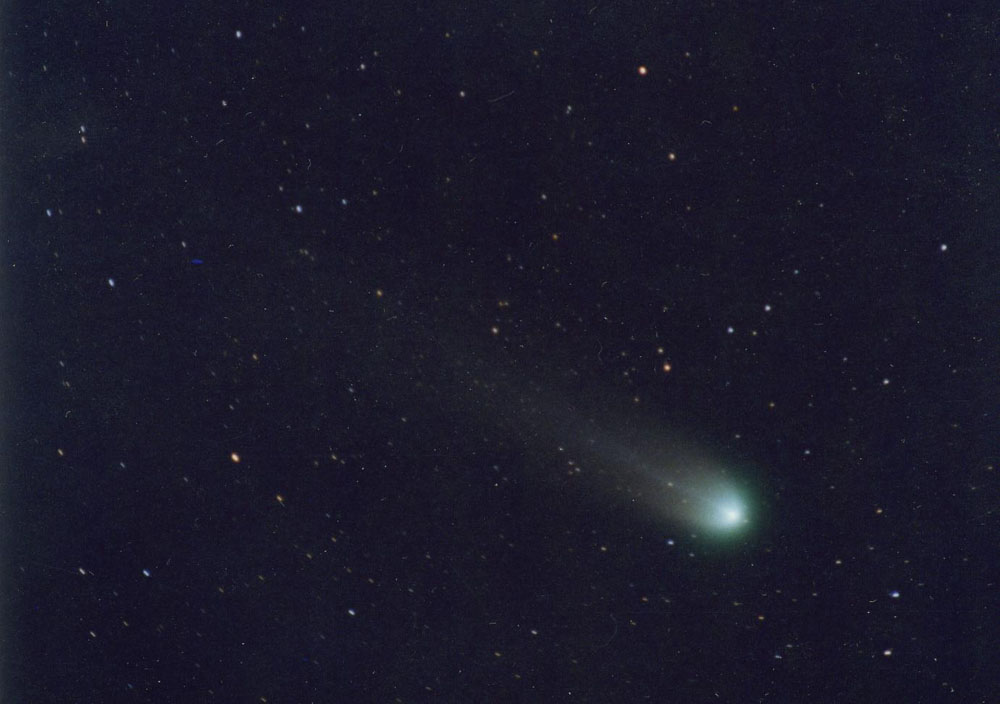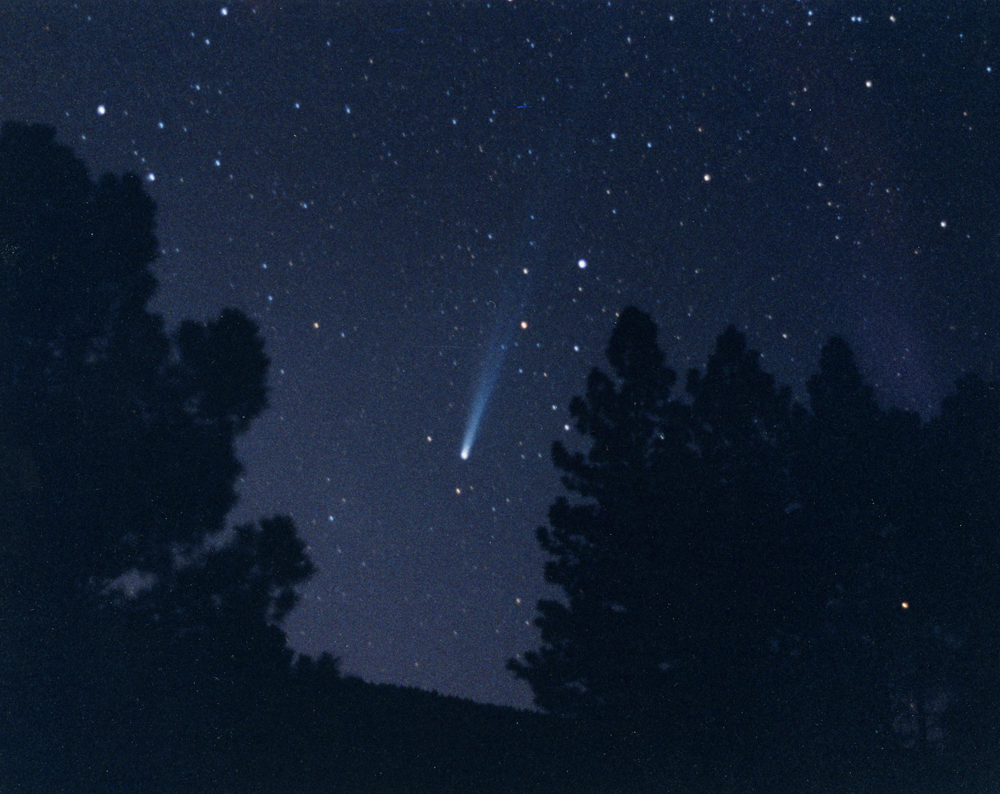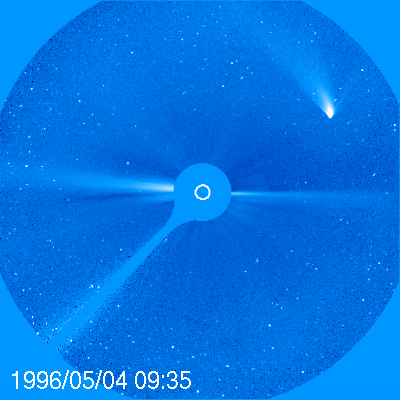

COMET OF THE WEEK
WEEK 13: MARCH 22-28
COMET HYAKUTAKE C/1996 B2
Perihelion: 1996 May 1.40, q = 0.230 AU
At the time of its discovery this newer Comet Hyakutake was about 10th magnitude and moving very slowly from night to night. Once its orbit was determined the reason for the comet’s slow apparent motion became obvious: it was headed almost directly towards Earth. It would pass only 0.102 AU from Earth on March 25 – the seventh-closest approach of any known comet to Earth in the 20th Century, and, intrinsically, the brightest comet to pass this close to Earth since the mid-16th Century.
Comet Hyakutake brightened rapidly during the ensuing weeks, and reached naked-eye visibility by the beginning of March. By mid-March it had brightened to 3rd magnitude and was exhibiting a coma almost one degree in diameter, with an ion tail up to five degrees long or longer. On the night of its closest approach, when it was located near the Big Dipper, it was as bright as magnitude 0, with a coma 1½ degrees in diameter, and according to my measurements exhibited an ion tail over 50 degrees long; telescopically the inner coma was quite active with distinct jetting activity. Two nights later, when the comet passed near the North Celestial Pole, the brightness had dropped slightly to 1st magnitude, however our view of the tail had become more broadside, and I measured a length of 70 degrees – the longest cometary tail I have ever seen – and some observers reported it as being as long as 100 degrees.

 Photographs I took of Comet Hyakutake on March 27, 1996. Left: Standard lens, giving the approximate naked-eye appearance. The bright star above the comet’s coma is Polaris. Right: Telephoto lens, giving the approximate appearance in binoculars.
Photographs I took of Comet Hyakutake on March 27, 1996. Left: Standard lens, giving the approximate naked-eye appearance. The bright star above the comet’s coma is Polaris. Right: Telephoto lens, giving the approximate appearance in binoculars.
The comet continued fading somewhat as it receded from Earth, and the apparent tail length also decreased somewhat, although by this time a dust tail was also beginning to appear; I was still measuring lengths as long as 45 degrees by mid-April. By this time its elongation was starting to get low as the comet made its approach to perihelion, and when it disappeared into evening twilight during the last week of April it was between 2nd and 3rd magnitude.
There was hope that the comet might brighten again as it passed through perihelion, but this did not happen. It did, however, put on a good showing in the LASCO coronagraphs aboard the joint NASA/ESA SOlar and Heliospheric Observatory (SOHO) spacecraft that had been launched in late 1995, where it exhibited not only regular ion and dust tails but also a straight third tail that analysis indicated was made up of massive particles that had been ejected from the nucleus during the preceding few days. Following perihelion it was picked up from the southern hemisphere during the second week of May as a 3rd-magnitude object deep in morning twilight with a bright 3-degree-long dust tail. It faded as it receded from the sun and traveled southward, dropping below naked-eye visibility in early June, with the final visual observations being obtained during the latter part of August and the final images being recorded in early November.

 LEFT: Photograph of Comet Hyakutake I took on the evening of April 16, 1996. RIGHT: Comet Hyakutake as it appeared in the LASCO C3 coronagraph aboard SOHO on May 4, 1996. Image courtesy NASA/ESA.
LEFT: Photograph of Comet Hyakutake I took on the evening of April 16, 1996. RIGHT: Comet Hyakutake as it appeared in the LASCO C3 coronagraph aboard SOHO on May 4, 1996. Image courtesy NASA/ESA.
As might be expected, Comet Hyakutake was intensely studied from a scientific standpoint, and was observed with a number of instruments, including the Hubble Space Telescope which detected the presence of several small “condensations” in the inner coma that were apparently very small fragments (no more than 15 meters across) that had recently broken off the nucleus. Meanwhile, radar bounce measurements obtained with NASA’s Deep Space Network antenna in Goldstone, California indicated that the nucleus was quite a bit smaller than expected, no more than 2 to 3 km in diameter. The fact that, intrinsically, the comet was as bright as it was – comparable to the intrinsic brightness of Comet 1P/Halley – indicates that a much larger percentage of the nucleus’ surface area was active than was Halley’s.
One other noteworthy scientific result came from analysis of magnetic field data taken by the joint NASA/ESA Ulysses spacecraft in May 1996, at which time Ulysses was located at a heliocentric distance of 3.7 AU. The data indicates that Comet Hyakutake's ion tail

Comet Hyakutake was the first “Great Comet” to appear after the development of much of modern computer and communications technology, including the Internet. It thus enjoyed a strong virtual presence, including a NASA-sponsored “Night of the Comet” World Wide Web “party” at the time of its closest approach to Earth. Together with the impacts of Comet Shoemaker-Levy 9 into Jupiter two years earlier and the display of Comet Hale-Bopp the following year – both of these objects being future “Comets of the Week” – Comet Hyakutake helped spawn a dramatic renewal of popular interest in comets during the mid- to late 1990s. Such are among the legacies of what was truly a most remarkable comet.
“Comet of the Week” archive
Ice and Stone 2020 home page
Earthrise Institute home page